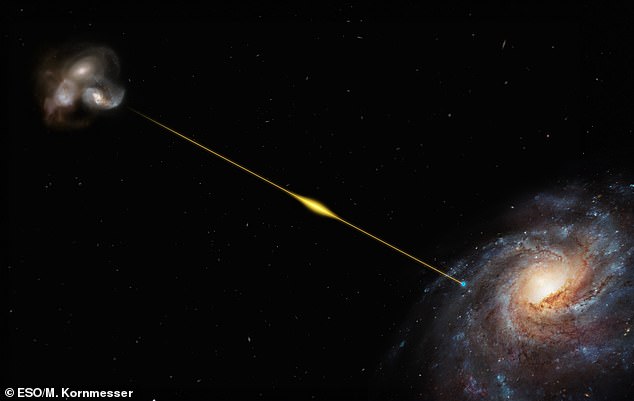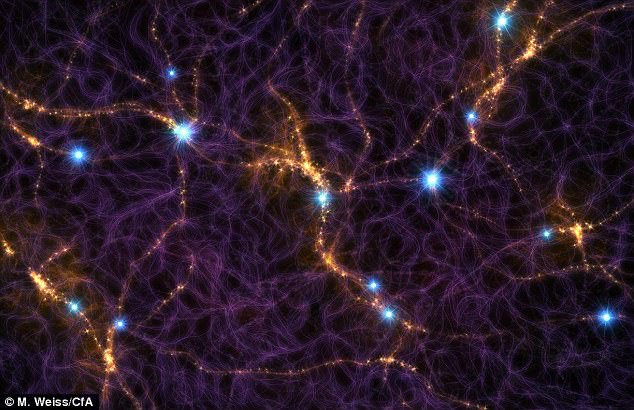Scientists have finally discovered the mysterious origins of a ‘foreign‘ signal received from outer space.
In 2022, a radio telescope detected a burst of energy from a galaxy about 200 million light years from Earth.
Although the explosion only lasted milliseconds, it contained enough energy to eclipse entire galaxies and was theorized to have been a sign of an advanced extraterrestrial civilization.
Now, MIT scientists have discovered that this ‘fast radio burst’ (FRB) originated in a small area extremely close to a rotating neutron star, the ultradense remains of a dead sun.
Researchers maintain that the explosion must have come from the layer of powerful magnetic fields surrounding the star known as the magnetosphere.
Although thousands of FRBs have been detected, this is the first time that astronomers have been able to pinpoint the origin of one of these mysterious signals.
Professor Kiyoshi Masui, co-author of the study, says: ‘Around these highly magnetic neutron stars, also known as magnetars, atoms cannot exist; they would simply be torn apart by the magnetic fields.
“The interesting thing here is that we discovered that the energy stored in those magnetic fields, close to the source, is twisted and reconfigured in such a way that it can be released in the form of radio waves that we can see in the middle of the universe.”
Scientists have revealed the origin of a mysterious “fast radio burst” signal (illustrated) that arrived from space in 2022. Although the signal only lasted two milliseconds, it briefly eclipsed some galaxies.
Neutron stars form when a star between seven and 19 times the size of our Sun explodes in a violent supernova, leaving behind a dense core of compressed matter.
Although they are only a few kilometers wide, these alien stars contain up to twice as much matter as the sun.
These stellar cores are so dense that a piece of neutron star material the size of a sugar cube would weigh a billion tons on Earth, making them the densest objects we can directly observe.
Surrounding these strange worlds are violent magnetic fields that can be billions of times stronger than those surrounding Earth.
Since the first FRB was detected in 2007, researchers have detected thousands of these brief but intense bursts everywhere from our own galaxy to 8 billion light years away.
Although these explosions do not contain enough energy to be dangerous, they have presented scientists with a perplexing mystery.
Some scientists have suggested that these could be created by the powerful magnetic fields surrounding distant neutron stars, but not all astronomers agree.
Lead researcher Dr Kenzie Nimmo says: “In these neutron star environments, the magnetic fields are really at the limits of what the universe can produce.
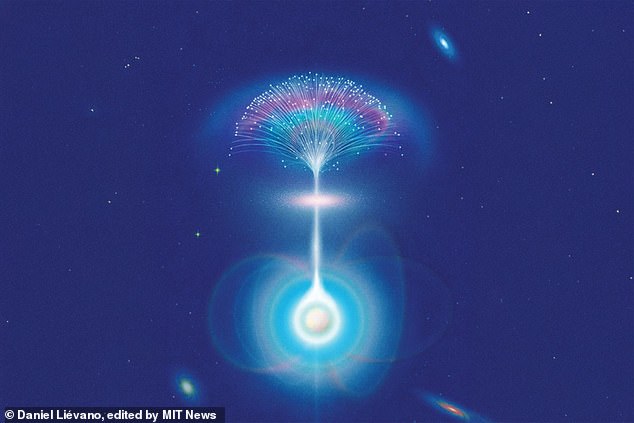
Researchers believe this powerful signal originated within the magnetic fields surrounding a neutron star, the ultradense remains of a dead star. As this explosion passed through gases in another galaxy, it split into multiple paths (illustrated), causing the signal to flicker brightly.
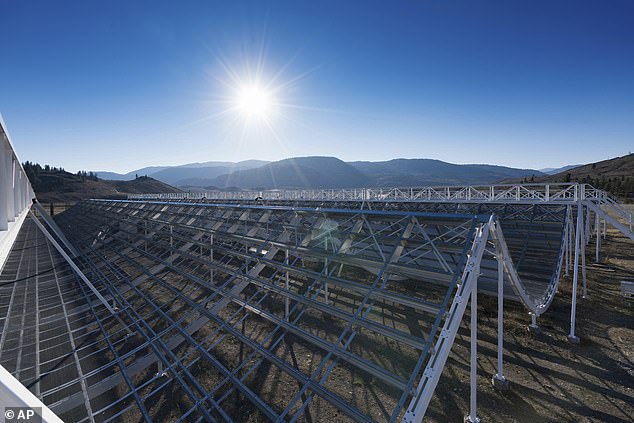
The signal was detected by the Canadian Hydrogen Intensity Mapping Experiment (pictured). By watching the signal flicker, the researchers calculated that it must have emerged from a region no more than 10,000 kilometers (6,200 miles) wide.
“There has been a lot of debate about whether this bright radio emission could escape from that extreme plasma.”
Some models suggest that the bursts of energy form in the turbulent magnetosphere, while others maintain that they originate from much further away as part of a shock wave from the star itself.
In their study, published in Nature, the researchers focused on a radio pulse detected in 2022 by the Canadian Hydrogen Intensity Mapping Experiment (CHIME).
Using four large, half-pipe-shaped radio receivers, scientists detected a two-millisecond pulse that they named FRB 20221022A.
Based on the highly polarized light that the FRB produced, the researchers found that its source is most likely spinning, something that has been observed in rapidly spinning neutron stars called pulsars.
But to find out exactly where FRB 20221022A originated, Dr. Nimmo and her co-authors looked at a property called “scintillation.”
If you see a star in the night sky from Earth, it appears to twinkle or “twinkle” because the star’s light is filtered through gases in the atmosphere.
This effect doesn’t just affect stargazers, however, as light from any small, bright source will bend as it passes through an obstruction, such as the gases surrounding a galaxy.
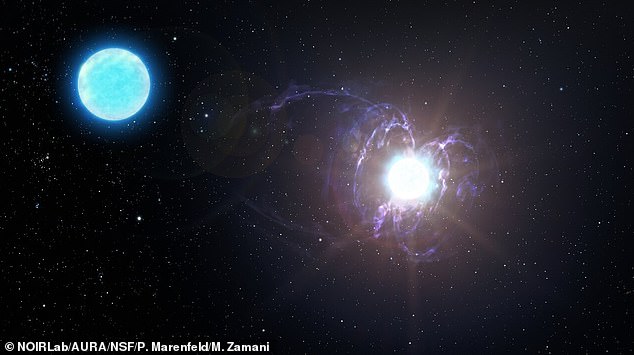
Researchers maintain that the explosion would have come from magnetic fields located hundreds of thousands of kilometers from a neutron star. This is the first evidence that the magnetosphere of a neutron star (illustrated) is capable of releasing a rapid radio burst.
The smaller and farther away the light source is, the more it twinkles, which is why planets like Jupiter and Mars don’t seem to twinkle when you see them.
If the FRB originated from a shock wave tens of millions of kilometers from the neutron star, the source area would be so large that researchers would not expect to see any scintillation.
But when Dr. Nimmo and her colleagues analyzed the energy of FRB 20221022A, they saw the mysterious flash twinkling like a star in the sky.
Dr Nimmo says: “This means that the FRB is probably hundreds of thousands of kilometers from the source.”
By identifying the cloud of gas that the flash must have passed through, researchers were able to get closer to its origin with unprecedented precision.
Although the FRB arose from a galaxy more than ten times the distance of our nearest neighbor galaxy, the researchers found that its origin was an area only 10,000 kilometers (6,200 miles) wide.
For comparison, that’s equivalent to the distance from Edinburgh to Cape Town, South Africa.
Professor Masui says: ‘Approaching a region of 10,000 kilometres, from a distance of 200 million light years, is like being able to measure the width of a DNA helix, which is about 2 nanometers wide, on the surface of the Moon. . ‘


